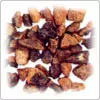To be considered suitable for use in a tropical freshwater aquarium, rocks must be of basaltic origin, stoneware, granite and lava. A marble rock should never be introduced into the aquarium, as it contains arsenic that will act as a pollutant in our small, closed ecosystem.

Nor will any stones containing calcium serve. To check if a rock is of calcareous origin, throw a few drops of hydrochloric acid, wait and watch carefully. If you see bubbling on the surface of the stone, do not use it, as this indicates the presence of calcium. This element will harden the water too much and make it alkaline.
The rocks of calcareous origin could be used very carefully in aquariums for African cichlids, since precisely their requirements regarding water conditions are that it is alkaline and hard. It is remembered that it is not easy to calibrate water parameters under these conditions for inexperienced aquarists.
In the case of cichlids especially, take care that the rocks do not have sharp edges, it will prevent the fish that dig between them from getting hurt. There are also many species that spawn on the rocks.
Another extremely important safety measure is to join the rocks when used in sets. It will prevent stones from moving or collapsing. A falling stone could hurt a fish or crush the eggs deposited there. The way to glue the rocks together is by using the same neutral silicone with which the aquarium glasses are glued.
Particular attention should be paid to the selection of rocks for the aquarium. If you do not have deep knowledge, some geology, do not take them from nature. Buy them from specialized stores. Some rocks can leach toxins that will affect water parameters and consequently fish. Stones of beautiful and intense colors usually owe such coloring to the presence of heavy metals, which will then pollute the water in the aquarium.
Toba rock is used only in marine water aquariums, NOT in freshwater.
You can place several boulders and they will look very beautiful. Group them together and attach them with neutral silicone for aquariums, so you can avoid collapsing. It is important to avoid accidents or even movements of rocks that alter the decoration done with care.
Wood is used in freshwater aquariums only. Trunks must come from a source that is reliable enough to ensure that disasters are avoided, such as entering green trunks that release chlorophyll or contain infections or fungi.

Trunks or roots must be pre-treated to avoid two main problems: floating and releasing tannins. The tannin, always present in the wood (unless it is cured), is released into the water and turns it with an orange to brownish tint.
Copies already processed can be obtained from specialized stores. The most suitable woods for the aquarium are bamboo and coconuts, while the most appropriate roots for the aquarium are those of swamp and vine.
If you collect wood from nature, you will need to be careful and evaluate the piece well. Make sure the trunks are not green, as they will release chlorophyll. Examine the wood for fungi or signs of rot that should be avoided.
When the collected piece was in the water there are advantages and disadvantages. The advantages are the assurance that the part is already in condition due to water saturation and not growing. On the disadvantage side, know that you risk the wood containing algae spores that can sprout and cause disaster in your aquarium.
To cure the wood to be introduced into the aquarium, first insert the piece of wood into boiling water for a couple of hours. This will remove the air inside, algae spores or fungi and part of the tannin.
Then keep the wood immersed in water for three to four weeks and periodically rub it with a soft bristle brush. Repeat the process of boiling and immerse the piece for ten more days, during which you will continue to rub with the same brush.
© Adrián Blanco 2005 / 2006 — No full or partial reproduction of text and/or images without explicit written consent of the author.
—
 General maintenance of the aquarium
General maintenance of the aquarium Diseases and treatments for fish Reproduction of aquarium fish Water resource: World Heritage Site Aquarium Ichthys Acuariophyll Association Argentina Purchase of aquarium fish Forum of Tropical Fish and Aquariums Compatibility between tropical fish Links to aquarianism and aquariophilia pages Snails in the aquarium Fish & Aquariums Finder
Diseases and treatments for fish Reproduction of aquarium fish Water resource: World Heritage Site Aquarium Ichthys Acuariophyll Association Argentina Purchase of aquarium fish Forum of Tropical Fish and Aquariums Compatibility between tropical fish Links to aquarianism and aquariophilia pages Snails in the aquarium Fish & Aquariums Finder